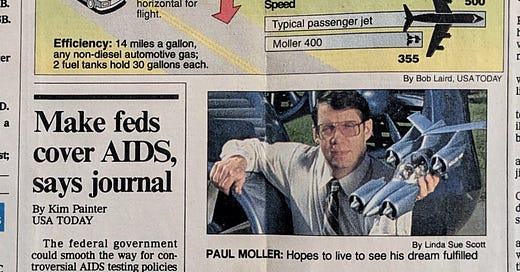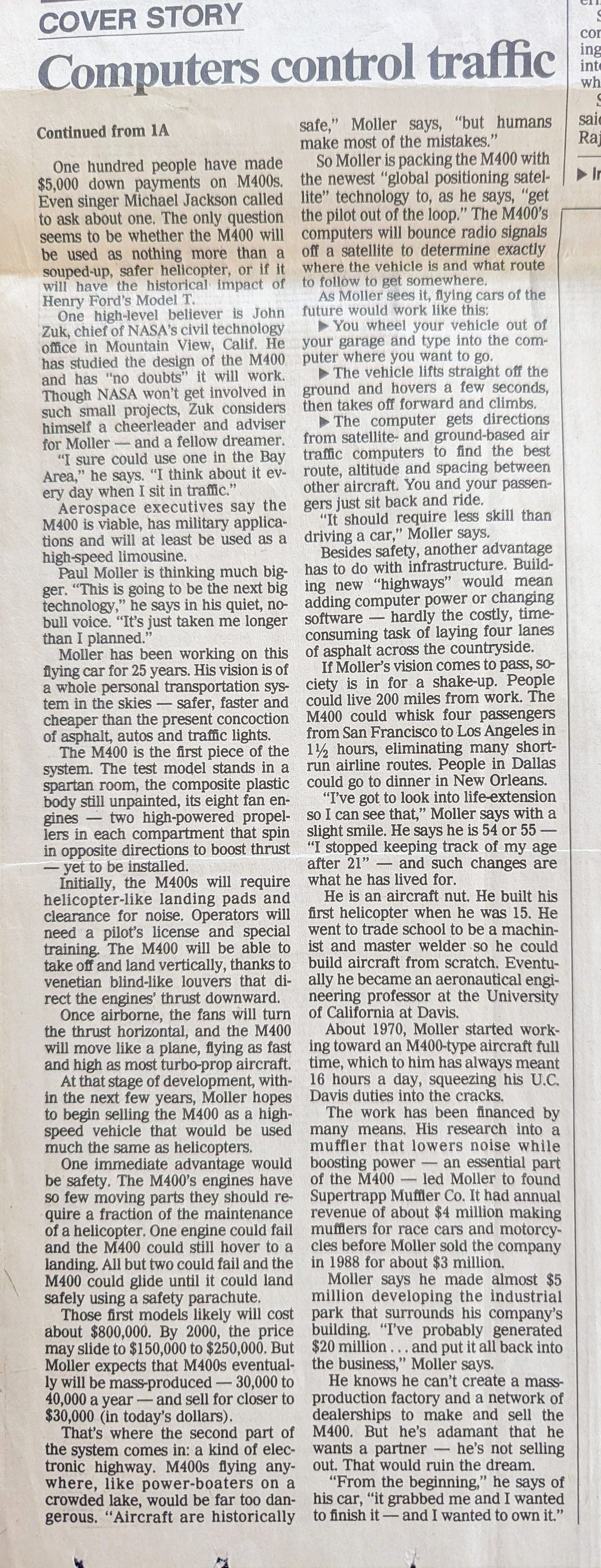A Visit With a Flying Car That Never Worked
Or, why too far ahead of your time isn't a good thing
Very, very soon, we’re all going to have flying cars. Which is also what Paul Moller told me in 1991 when I went to see the Skycar M400 he was building in Davis, Calif.
From what I’ve read these days, there are a number of legit flying cars in development now, some with the backing of car companies like Hyundai and Toyota and one, from Chinese company XPeng AeroHT, that wowed attendees of the Consumer Electronics Show in January and is about to go into full-scale production. Chaos in the skies can’t be far behind.
But in 1991, there was pretty much one place to go to see an actual, maybe-it-will-eventually-work flying car, and that was in Moller’s shop. Here’s what I wrote for USA Today in May of 1991:
“The M400, Moller’s first model, looks like a cross between a Corvette and a Cuisinart and is supposed to make its first test flight this year. By 2000, M400s could fly four passengers at up to 355 miles MPH, land like a helicopter, park in garages and be safer than Volvos with air bags. By then, the vehicles should cost less than a Porsche 944.”
I also noted that Michael Jackson called Moller to ask if he could buy one.
But, yeah, none of that actually worked out.
Moller, who is now 87 and lives in Canada (where he was born), was an odd character who obsessively worked on flying cars for decades, burned through who-knows-how-much investor money, and never made a viable model. By the time I interviewed him in 1991, he’d been at it for 25 years. Then Moller got sued by the Securities and Exchange Commission for defrauding investors. Moller settled without admitting guilt. By 2009, his company was $43 million in the hole. And still no Skycar.
I have vague memories of going to Davis and spending time with Moller. He seemed socially awkward, savant-like brilliant and not quite living in the real world. Since the idea of a real flying car – not just the cartoon flying cars in The Jetsons – was new to most people, I spent the bulk of the story describing how it would work and how we’d use one. When I noted it would eventually fly on autopilot, I wrote that it would be armed with “global positioning satellite technology”…and then had to explain what it was.
When I wrote the story, the most fascinating part of it was just the idea that a flying car might actually come to pass. But looking back, I think the more fascinating part really was Moller.
He told me he was, at the time, 54 or 55 – “I stopped keeping track of my age after 21.” He built a helicopter when he was 15, learned welding so he could build aircraft from scratch, and eventually became an aeronautical engineering professor at the University of California at Davis – which is why he was in Davis, about 15 miles west of Sacramento.
As he worked on his flying car, he kind of accidentally developed the Supertrapp Muffler, started a company to sell it for race cars, and sold the company in 1988 for $3 million. Then he developed the industrial park around his garage in Davis and made $5 million off that – plowing everything he made back into the Skycar. The Skycar ate his life. “From the beginning, it grabbed me and I wanted to finish it, and I wanted to own it,” Moller told me.
Three years later, I caught up with him again. He got in touch because he said he was a few months away from a first flight in the Skycar, which he planned to take himself. But that never came to pass. Soon to come were the SEC suit and other troubles. A Wikipedia entry about Moller says, “In April 2009, the National Post characterized the Moller M400 Skycar as a 'failure', and described the Moller company as ‘no longer believable enough to gain investors.’”
Writing all this just kind of makes me feel bad. What must it feel like to devote your whole life to something that essentially fails to materialize?
In category design, we talk about the concept of the adjacent possible. New inventions take hold when they are just beyond the possible – just stretching the technologies we already have and use. Yet they are not so far into the impossible that the technology won’t work and the public won’t get it.
Sometimes companies with a grand vision get too far out into the impossible and never catch on before they run out of money. Moller was clearly way, way, way out beyond the adjacent possible in 1991.
But the latest news about flying cars suggests that maybe…just maybe…the technology is near hitting the adjacent possible. And if that’s true, within a few years all those people who thought they were so cool because they bought the first Teslas – they’ll be lining up to buzz overhead in some kind of cross between a Corvette and a Cuisinart.
Here is the story as it appeared in USA Today on May 23, 1991. It is not available online.






The other thing about flying cars, is that the more they resemble a car that can fly (IE you can drive it) the less likely they are to succeed.
This because they will be both a crap car and a crap plane. Horrible to drive and worse to fly. The worst of both worlds.
When people say we are getting closer to flying cars, what it usually means is that we are getting closer to an affordable, parkabke VTOL, but there is little car-like about them.
Saying “Flying Car” now is akin to saying “horseless carriage” a hundred years ago.
You know what comes next… a new category!
This will never happen becaus most people are very bad drivers and when you have an accident it's just a simple thing on the ground but flying accident will usually be fatal most of the time.